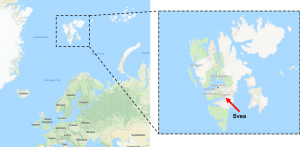Summary of Field Work on Sea Ice performed in Svalbard, March 2018
By Rebekah Yore, on 26 April 2018
Article written by Mark Shortt
For two weeks in March 2018, I travelled to the Arctic archipelago of Svalbard to conduct field experiments on sea ice as part of my PhD research. Svalbard is located at 74°-81°N, around halfway between mainland Norway and the geographic north pole. Travelling to Svalbard requires taking a 2-hour flight from the Norwegian city of Tromsø to Longyearbyen, the largest settlement on the archipelago with a population of just over 2000 people.
Once arrived in Longyearbyen, I went to the University Centre in Svalbard (UNIS), a local university specialising in Arctic studies. Here I met the team of researchers who I would be joining on the field expedition, led by Aleksey Marchenko, Professor of Ice Mechanics at UNIS. The field site was located within Van Mijenfjorden, an 83km long fjord approximately 50km south of Longyearbyen. Getting to the field site involved a roughly 3-hour long snowmobile journey from Longyearbyen to Svea, a small mining settlement located on the northern coast of the fjord. Here it was possible to stay in the mining lodges and eat in the communal canteen. The field site was located on the sea ice within the fjord, around a 10 minute snowmobile journey from Svea.

The edge of the sea ice cover in Van Mijenfjorden, located at Cape Amsterdam. Hidden in the clouds in the background is the Skobreen glacier
Sea ice occurs when the temperature of the air is lower than the temperature of the sea water for prolonged periods of time, reaching its maximum extent towards the end of the cold season. For the Northern Hemisphere, this corresponds to around late February and early March, which is why the field work was arranged at this time. The initial ice thickness at the field location within the fjord was around 60cm, but increased over the two week period. The air temperature over the field work period ranged between -10°C and -25°C.
My research focuses on investigating the physical properties and strength of consolidated sea ice. The process of consolidation occurs in rafted and ridged sea ice – two commonly occurring features in the Arctic sea ice cover. Over time, freeze-bonds form between the constituent ice pieces, resulting in an overall strengthening of the features. When driven by winds and/or ocean currents, consolidated rafted and ridged sea ice may pose considerable risks to offshore structures and vessels operating in the region. It is therefore important that the physical and mechanical properties of the ice are well characterised over the consolidation period.
Large scale consolidation experiments were conducted with the aim of determining the time required for stacked blocks of sea ice to bond. Two experiments were set-up with differing ice orientations to investigate the effect of brine drainage on the physical properties and strength over the consolidation period. In both experiments, the temperature and salinity profiles through the ice were measured. In addition, the crystal structure of the freeze-bond layers formed between the ice blocks were deduced by taking thin sections of cored samples.
Other tests were conducted by the field group, with the aim of investigating the mechanical properties of sea ice. These included cantilever and Sodhi beam tests, drop block tests, small scale tensile and bending tests as well as full scale uniaxial compression tests. The influence of a vibroplate on the mechanical experiments was also investigated.
Due to incoming bad weather we were forced to leave the field site and return to Longyearbyen one day early. Unfortunately, this meant that I was limited in the number of strength tests that were performed in my experiment, the majority of which were scheduled for the final day. However, I believe that the results obtained will prove a useful comparison to similar smaller-scale tests to be conducted in the laboratories at UCL.
I would like to thank my supervisor, Professor Peter Sammonds for providing feedback and recommendations for my experimental plan prior to the field expedition. Special thanks to Aleksey Marchenko for the invitation for field work, and for the assistance in developing the experimental methodology. I also appreciate the support and hospitality of the other members of the field team throughout the expedition. Finally, thank you to the members of SAMCoT for providing the funds necessary for the undertaking of the experiments.
 Close
Close




